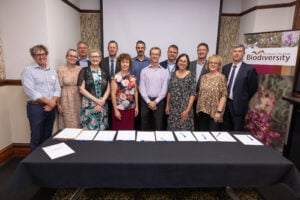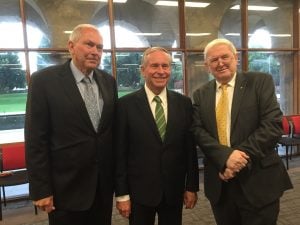The WABSI joint venture partnership represents leading biodiversity science research expertise in Western Australia. The partnership enables WABSI to develop end user driven biodiversity research programs that are collaborative and can more effectively address priority knowledge needs.
Joint venture partners
- CSIRO
- Curtin University
- Department of Biodiversity, Conservation and Attractions
- Department of Water and Environmental Regulation
- Department of Mines, Petroleum and Exploration
- Department of Primary Industries and Regional Development
- Edith Cowan University
- Murdoch University
- The University of Western Australia
- Western Australian Museum
Funding
We are funded by the Western Australian Government through the Department of Energy and Economic Diversification.
Our supporters
We acknowledge ongoing support from the following organisations:
- Alcoa
- ANZ Bank
- Association of Mineral and Exploration Companies
- Bechtel
- BHP
- Bush heritage
- Cameco
- Chamber of Minerals and Energy
- CSIRO
- Curtin University
- Environmental Consultants Association and members
- Environment Institute of Australia and New Zealand and members
- Environmental Protection Authority
- Fortescue Metals Group
- Greening Australia
- Hanson
- Infrastructure Sustainability Council of Australia
- Mineral Resources
- Minerals Council of Australia
- Minerals Research Institute of WA
- Newmont
- Northern Agricultural Catchments Council
- NRM WA
- Pawsey Supercomputing Research Centre
- Peel Harvey Catchment Council
- Perth NRM
- RaboBank
- Rangelands NRM
- RioTinto
- Roy Hill
- South Coast NRM
- South West Catchments Council
- South32
- Urban Development Institute of Australia and their members
- WA Local Governments Association
- Wheatbelt NRM
Our history: Story of the WABSI partnership
2023 – Research partnership renewed
WABSI joint venture partners renewed the successful partnership for a further 5 years until 2028, following funding from the WA government through the Department of Jobs, Tourism, Science and Innovation.
To celebrate this milestone, WABSI hosted a Research Symposium in November 2023 where early career researchers from each partner organisation, presented on a diverse range of topics, providing a great opportunity to share knowledge and to explore avenues for further collaboration on biodiversity research.
Since it was first established, WABSI’s funding and the joint venture partnership has been renewed several times, enabling it to lead and facilitate research collaboration to address complex biodiversity issues.

Photo above: Professor Owen Nevin, CEO, WABSI with senior leaders from partnership organisations at the signing of the renewed agreement, November 2023
2015 – The launch of WABSI
WABSI was officially launched in October 2015, with funding from the Western Australian Government through the Department of Jobs, Tourism, Science and Innovation.
With Inaugural Board Chair Professor Mick Poole, the first executive team member, Peter Zurzolo, CEO, was appointed in May 2016.
WABSI’s host institution was The University of Western Australia, which provided corporate support services.
The foundation members that helped to establish WABSI included the following organisations:
- The University of Western Australia
- Curtin University
- Murdoch University
- CSIRO
- Department of Biodiversity, Conservation and Attractions
- The Chamber of Minerals and Energy
- Environmental Protection Authority
- Department of Mines, Industry Regulation and Safety
- Botanic Gardens and Parks Authority
- Western Australian Museum
- BHP

Photo above: Inaugural WABSI Board Chair, Professor Mick Poole, Former WA Premier Colin Barnett and UWA Professor Alan Robson at the WABSI launch in October 2015
2013 – A two-year end user consultation process identified a need for WABSI
In early 2013, a Steering Group was established, with representatives from research agencies, government advisory agencies and industry.
In conjunction with an independent consultant, the Steering Group oversaw a wide consultation process with end users . This revealed a clear need for a collaboration mechanism that could be independent and address priority knowledge needs for end users. This led to the establishment of The Western Australian Biodiversity Science Institute.